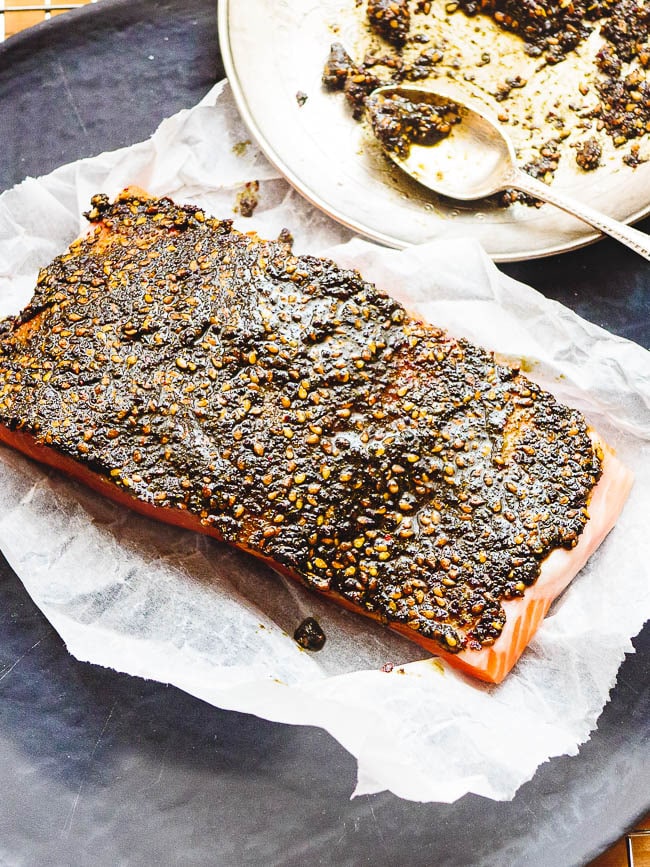It’s no wonder salmon has taken the world by storm. Possible health benefits aside, it’s an incredible vehicle for flavour, easily adapted to pre-existing local customs. My favourite? Middle Eastern. Baked salmon works incredibly well with Middle Eastern flavours. And what better Middle Eastern flavours are there than za’atar and sumac? It’s a match made in heaven.
I’m not sure if it’s the accent or the limited vocabulary that first gives me away, but whenever I encounter someone new, the following conversation usually ensues within the first minute.
— Where are you from?
— Norway.
— Ah! Fish! Salmon! Norwegian salmon!
A small country far north, most Turks probably know nothing about Norway. But they’ve seen the signs at the fishmongers.
Salmon – i.e. Turkish bred. Or Norwegian salmon, at twice the price.
Norwegian salmon must be one of the most successful branding stories of recent times.
A perfect vehicle for all sorts of flavours
It’s true that the majority of the world’s salmon is produced in Norway.
It’s not true, however, that we grow up eating salmon every day, as some appear to think. In fact, until the fairly recent advent of large scale fish farming, salmon was caught wild from the rivers and reserved for big occasions, usually simply baked as it is, cured or smoked. Flavour additions have usually been limited to dill, juniper or aquavit.
As salmon has taken the world by storm in recent years, one thing has become apparent for those of us used to the simple versions: Salmon is an incredibly versatile vehicle for flavour. It is happy to blend in with most food cultures’ already existing flavour profile, be they Asian, Pacific or Middle Eastern.

One of my favourite ways of preparing salmon is inspired by the latter, topped with a mouthwatering spice mix shouting Middle East from the rooftops.
Za’atar baked salmon.
Salmon loves za’atar & sumac
Za’atar is a versatile spice mix consisting of a ground wild mountain herb reminiscent of thyme or oregano, toasted sesame seeds and sumac, a spice made from sour berries. Other spices may be added too, but these three spices are what makes the spice mix.
One of the reasons people rave so much about za’atar, is its versatility. It goes well with just about anything. Try it on your breakfast eggs, with roast vegetables or pulses, with chicken or on bread.
And, of course, salmon!

The combination of fragrant herbiness, umami from the sesame seeds and complex sourness from the sumac, makes it the perfect match for baked salmon.
Since salmon is an oily fish, I add a little extra sumac to offset. Delicious!
How to prepare za’atar baked salmon – and what to serve alongside
Za’atar baked salmon is an easy dish to make, perfect for a weeknight supper. All you need to do, is mix the spices with a little olive oil, spread it on top of the salmon and leave the rest to your oven.
The most important thing is to keep an eye on the oven, so the salmon is baked to perfection. In this respect, low heat is your best friend.


Since the fish comes with a ton of flavour, courtesy of the generous amounts of za’atar topping, simple goes a long way as far as sides are concerned.
Personally, I prefer a slightly tart salad and some plain rice. Roast vegetables also work really well with za’atar baked salmon (extra za’atar on top of the veggies!).
While a perfectly baked salmon doesn’t need any sauce, this goes incredibly well with anything tahini. I often make a version of a Palestinian tahini sauce with onions that is often baked with (white) fish, and find it works incredibly well.
A simple dish of sautéed collard greens with a simple tahini sauce (tahini, lemon juice, olive oil, cumin) is another delicious option I learned of from Ana Sortun. She’s recently contributed a recipe to cookbook The Tahini Table, which she also shared in her Instagram Stories a few days ago.
This recipe serves four with a couple of substantial sides alongside – two if you’re looking for a high protein low carb sort of meal. I like having the salmon in one or two large pieces, but you can also use individual fillets – just remember it may shorten the cooking time a little.

Za’atar baked salmon
Ingredients
- 600 g salmon filet, I prefer thick, skin-on pieces
- salt
Za’atar topping
- 2 Tbsp za’atar
- 1 Tbsp sumac
- 1 Tbsp olive oil, I use a mild extra virgin
- ¼ tsp salt
- ¼ tsp black pepper, I use freshly ground
How I make it
- Pre-heat the oven to
140 °C, fan.
- Oil or place a baking paper in an oven dish that fits the salmon snugly.
- Salt the salmon (keeping in mind there is a salt in the za’atar topping too) and place on the oven dish, skin side down.
- Mix all the ingredients for the za’atar topping. Spread it gently on top of the salmon fillets.
- Bake in the middle of the oven until the salmon is as you like it, 10-15 minutes. How long the salmon needs depends on how well-cooked you like your salmon as well as the effectiveness of your oven. The salmon pictured is 300 grams and I roasted it for 13 minutes. Serve immediately with your preferred sides.















3 responses
Just what I was looking for my dinner tonight
Happen yo have the right fish Norwegian salmon and za’atar sumac etc
I really like the za’atar salmon. I didn’t have sumac so I substituted lemon pepper.
I do have a question. Since za’atar has sumac in it why did you add extra?
Thanks
Glad to hear you enjoyed it! The extra sumac is there to get a little more of the tanginess than you get from just za’atar alone. It goes very well with fatty fish.